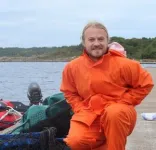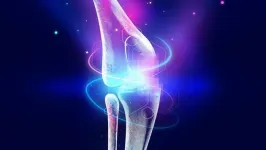(Press-News.org) Researchers at Trinity College Dublin have recovered remarkably preserved microbiomes from two teeth dating back 4,000 years, found in an Irish limestone cave. Genetic analyses of these microbiomes reveal major changes in the oral microenvironment from the Bronze Age to today. The teeth both belonged to the same male individual and also provided a snapshot of his oral health.
The study, carried out in collaboration with archaeologists from the Atlantic Technological University and University of Edinburgh, was published today in leading journal Molecular Biology and Evolution. The authors identified several bacteria linked to gum disease and provided the first high-quality ancient genome of Streptococcus mutans, the major culprit behind tooth decay.
While S. mutans is very common in modern mouths, it is exceptionally rare in the ancient genomic record. One reason for this may be the acid-producing nature of the species. This acid decays the tooth, but also destroys DNA and stops plaque from fossilising. While most ancient oral microbiomes are retrieved from fossilised plaque, this study targeted the tooth directly.
Another reason for the scarcity of S. mutans in ancient mouths may be the lack of favorable habitats for this sugar-loving species. An uptick of dental cavities is seen in the archaeological record after the adoption of cereal agriculture thousands of years ago, but a far more dramatic increase has occurred only in the past few hundred years when sugary foods were introduced to the masses.
The sampled teeth were part of a larger skeletal assemblage excavated from Killuragh Cave, County Limerick, by the late Peter Woodman of University College Cork. While other teeth in the cave showed advanced dental decay, no cavities were visible on the sampled teeth. However, one tooth produced an unprecedented amount of S. mutans DNA, a sign of an extreme imbalance in the oral microbial community.
“We were very surprised to see such a large abundance of S. mutans in this 4,000-year-old tooth,” said Dr Lara Cassidy, an assistant professor in Trinity’s School of Genetics and Microbiology, and senior author of the study. “It is a remarkably rare find and suggests this man was at a high risk of developing cavities right before his death.”
The researchers also found that other streptococcal species were virtually absent from the tooth. This indicates the natural balance of the oral biofilm had been upset – mutans had outcompeted the other streptococci leading to the pre-disease state.
The team also found evidence to support the "disappearing microbiome" hypothesis, which proposes modern microbiomes are less diverse than those of our ancestors. This is cause for concern, as biodiversity loss can impact human health. The two Bronze Age teeth produced highly divergent strains of Tannerella forsythia, a bacteria implicated in gum disease.
“These strains from a single ancient mouth were more genetically different from one another than any pair of modern strains in our dataset, despite the modern samples deriving from Europe, Japan and the USA,” explained Iseult Jackson, a PhD candidate at Trinity, and first author of the study. “This represents a major loss in diversity and one that we need to understand better.”
Very few full genomes from oral bacteria have been recovered prior to the Medieval era. By characterising prehistoric diversity, the authors were able to reveal dramatic changes in the oral microenvironment that have happened since.
Dr Cassidy added: “Over the last 750 years, a single lineage of T. forsythia has become dominant worldwide. This is the tell-tale sign of natural selection, where one strain rises rapidly in frequency due to some genetic advantage it holds over the others. T. forsythia strains from the industrial era onwards contain many new genes that help the bacteria colonise the mouth and cause disease.
“S. mutans has also undergone recent lineage expansions and changes in gene content related to pathogenicity. These coincide with humanity’s mass consumption of sugar, although we did find that modern S. mutans populations have remained more diverse, with deep splits in the S. mutans evolutionary tree pre-dating the Killuragh genome.”
The scientists believe this is driven by differences in the evolutionary mechanisms that shape genome diversity in these species.
“S. mutans is very adept at swapping genetic material between strains,” said Dr Cassidy. “This means an advantageous innovation can be spread across S. mutans lineages like a new piece of tech. This ability to easily share innovations may explain why this species retains many diverse lineages without one becoming dominant and replacing all the others.”
In effect, both these disease-causing bacteria have changed dramatically from the Bronze Age to today, but it appears that very recent cultural transitions in the industrial era have had an inordinate impact.
END
Scientists extract genetic secrets from 4,000-year-old teeth to illuminate the impact of changing human diets over the centuries
2024-03-27
ELSE PRESS RELEASES FROM THIS DATE:
Treatment of advanced non-small cell lung cancer with driver mutations
2024-03-27
Lung cancer is the leading cause of cancer-related death worldwide. Improved understanding of driver mutations of non-small cell lung cancer (NSCLC) has led to more biomarker-directed treatment for patients with advanced stages. The expanding number of drugs targeting these driver mutations offers more opportunity to improve patient’s survival benefit.
To date, NSCLCs, especially those with non-squamous histology, are recommended for testing epidermal growth factor receptor (EGFR) mutations, anaplastic lymphoma kinase (ALK) gene rearrangements, ROS proto-oncogene receptor tyrosine kinase 1 (ROS-1) rearrangements, B-raf proto-oncogene (BRAF) mutations, rearranged during transfection ...
UK rabbit owners can recognize pain in their pets, study finds
2024-03-27
Rabbits are popular family pets, with around 1.5 million* in the UK and it is important that owners can recognise when their animal is in pain, and know when to seek help to protect their rabbit’s welfare. New research by the University of Bristol Veterinary School has found the majority of rabbit owners could list signs of pain and could mostly identify pain-free rabbits and those in severe pain, but many lacked knowledge of the subtler sign of pain.
The study, published in BMC Veterinary Research today [27 March], provides the first insight into how rabbit owners identify pain and their general ability to apply this knowledge to detect pain ...
World's first demonstration that forests trap airborne microplastics
2024-03-27
A research group led by Japan Women’s University finds that airborne microplastics adsorb to the epicuticular wax on the surface of forest canopy leaves, and that forests may act as terrestrial sinks for airborne microplastics
Tokyo, Japan – Think of microplastics, and you might think of the ones accumulating in the world’s oceans. However, they are also filling the sky and the air we breathe. Now, it has been discovered that forests might be acting as a sink for these airborne microplastics, offering humanity yet another ...
How will you age? World-leading Dunedin Study launches next phase
2024-03-27
The world-leading Dunedin Study is set to launch its age 52 assessments, delving into an understudied but important period of life and time of change.
The Dunedin Multidisciplinary Health and Development Study is a longitudinal study that follows the lives of 1037 babies born in Queen Mary Maternity Hospital between 1 April 1972 and 31 March 1973. It is the most detailed study of human health and development in the world.
Members have been assessed regularly throughout their lives, most recently at age 45.
Study Director, Research Professor Moana Theodore is incredibly excited ...
Opportunistic emergency department stop smoking prompt helps smokers quit
2024-03-27
An opportunistic emergency department stop smoking prompt, comprising brief advice by a trained professional, an e-cigarette starter kit, and referral to local stop smoking services can help smokers quit, with a significant proportion of them still not smoking 6 months later, finds research published online in Emergency Medicine Journal.
Some 6.4 million people in the UK still haven’t stubbed out for good, and of the large numbers of people attending emergency departments, a substantial proportion are more likely to be smokers and have poorer overall health, explain ...
Consistently exercising 2-3 times a week over the long term linked to lower current insomnia risk
2024-03-27
Consistently exercising 2-3 times a week over the long term is linked to a lower current risk of insomnia as well as the ability to clock up the recommended 6-9 hours of shut eye every night, suggests an international 10-year study published in the open access journal BMJ Open.
Regular exercise is associated with better overall health, and several studies have suggested that physical activity promotes better quality sleep and may improve symptoms of chronic insomnia, note the researchers.
But it’s not entirely clear how much gender, age, weight (BMI), overall fitness, general health and exercise ...
Handing out vapes in A&E helps smokers quit
2024-03-27
Peer reviewed – randomised controlled trial - humans
Giving out free e-cigarette starter packs in hospital emergency departments to people who smoke helps more people quit – according to research from the University of East Anglia.
The trial, funded by the National Institute for Health and Care Research (NIHR), offered advice, an e-cigarette starter pack and referral to stop smoking services to people attending A&E for any reason, to help them to stop smoking.
Six months later, almost one in four people given the starter packs said they had quit smoking. And those who received ...
Shared digital NHS prescribing record could avoid nearly 1 million annual drug errors
2024-03-27
Implementing a single shared digital prescribing record across the NHS in England could avoid nearly 1 million drug errors every year, stopping up to 16,000 fewer patients from being harmed, and saving up to 22 lives every year, suggests a modelling study, published online in BMJ Quality & Safety.
The figures, which are based on the assumption that such a system could reduce medication errors by at least 10%, and by as much as 50%, could also save £millions for the NHS, say the researchers.
Previously published research suggests that drug errors cost the NHS £98 ...
Stanford Medicine-designed AI tools tackle soft tissue sarcomas, identify new treatment strategies
2024-03-26
Using novel machine learning tools developed at Stanford Medicine, researchers have mapped three distinct cellular configurations that correspond to clinical outcomes for patients with a rare, difficult-to-treat cancer called soft tissue sarcoma.
In particular, the technique identified a cellular neighborhood that correlated with a positive response to immunotherapy, which may help physicians make treatment decisions.
“These cancers are challenging,” said Everett Moding, MD, PhD, an assistant professor of radiation oncology. “Up to half of patients diagnosed with a primary tumor will develop distant metastases, but we don’t have a good way to predict ...
ARPA-H awards Columbia researchers nearly $39M to develop a living knee replacement
2024-03-26
A team of researchers from Columbia University Irving Medical Center (CUIMC) and Columbia Engineering has been awarded up to a $38.95 million contract from the Advanced Research Projects Agency for Health (ARPA-H) to build a living knee replacement from biomaterials and human stem cells, including a patient’s own cells. ARPA-H is a federal funding agency that funds transformative biomedical and health research breakthroughs, rapidly translating research from the lab to applications in the marketplace.
The Award
The award, part of the ARPA-H’s Novel Innovations for Tissue Regeneration ...





